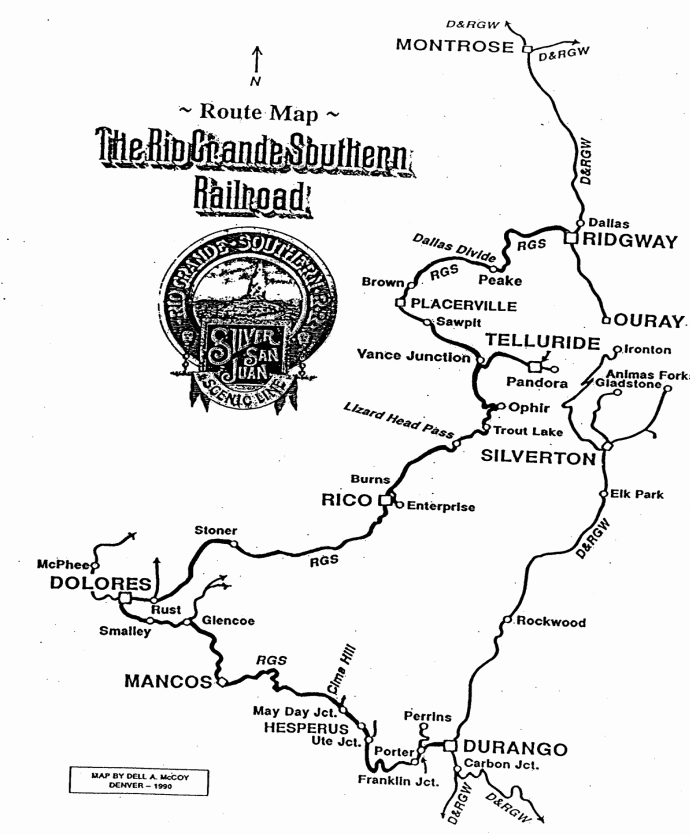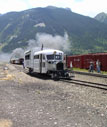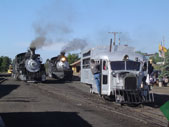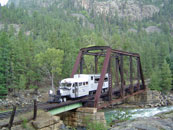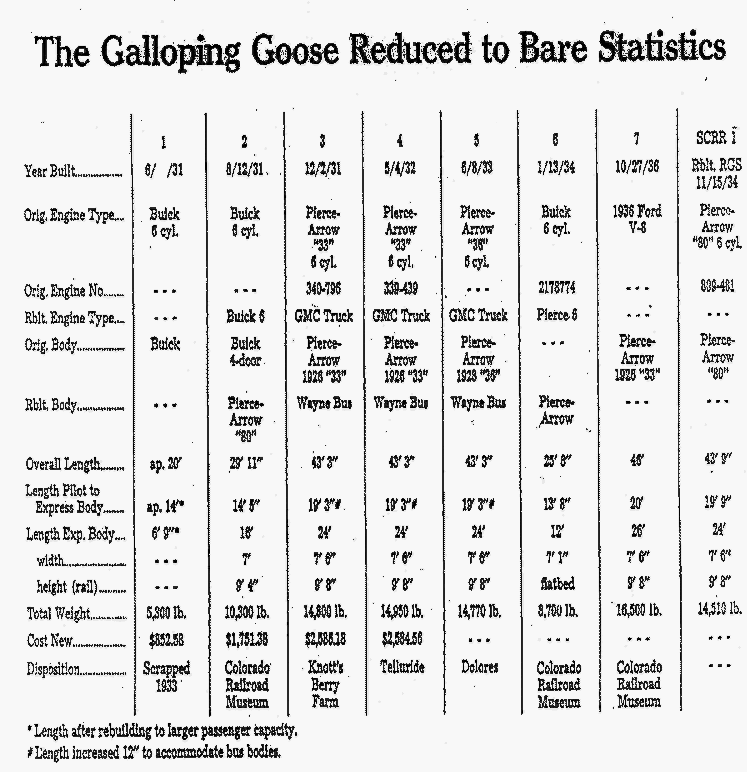& The Galloping Goose
By Larry Spencer, President,
Galloping Goose Historical Society of Dolores, Inc.
If the Rio Grande Southern Railroad had ever been a profitable endeavor with the changing economy of its fledgling days, the “Galloping Goose” might never have been “hatched” to accommodate travel by rail in the remote and isolated regions of far southwestern Colorado. The railroad was conceived and built in 1890-91 by the unflappable “Pathfinder of the San Juans,” Otto Mears. It was over 160 miles long and ran from the town of Ridgway, Colorado on the north to Durango, Colorado on the south going through the towns of Telluride, Rico, Dolores and Mancos.
The RGS’s early revenues came mainly from the numerous silver and gold mines near Telluride, Ophir and Rico. Hauling hundreds of tons of precious metal ores and hundreds of passengers in and out of the area made the financial condition of the railroad extraordinarily strong for its first two and one-half years! However, the repeal of the Sherman Silver Purchase Act caused the Silver Panic of 1893, and silver prices plummeted. As a result, many silver mines were closed, people fled the area by the thousands, and the railroad slipped into its first receivership that same year.
Nevertheless, the railroad survived – just barely at times – for another 40 years hauling various kinds of freight and passengers until the stock market crash in 1929 spelled the almost certain financial failure of the railroad. However, there remained an obligation and responsibility for the railroad to provide reliable transportation for small amounts of freight, what few passengers there were, and the always-important U.S. Mail. It was time to economize! There had to be a way! There was. A new rail vehicle was born from an ingenious idea and developed into what later became widely known as the Galloping Geese.
In June 1931, the first “Motor” was built by master mechanic Jack Odenbaugh and his crew at the Southern’s Ridgway shops. (Many locals referred to the RGS as simply “the Southern.”) Eventually there was a fleet of seven in operation on the RGS. Motor No. 5 went into service on June 8, 1933. (The railroad officially called these vehicles Motors until 1950.)
The cost was $2,599 for No. 5, which was built with a 1928 Pierce-Arrow limousine body and running gear. It was rebuilt in 1946/47, using a World War II surplus GMC gasoline truck engine and a Wayne Corporation school bus body. In 1950, the freight/mail compartment was converted to carry 20 additional passengers for sightseeing trips. With a one-man crew, and operating on gasoline rather than steam, our local Galloping Goose and its fellow goslings fit the bill for economic travel.
Even though originally built from Buicks and Pierce Arrows, the word “dignified” never seems to have been included in their description, but they were serviceable and definitely fit their purpose. Traveling through the countryside with a horn that could easily be mistaken for the call of a real goose, they were said to have “waddled” down the uneven, poorly maintained tracks of the cash-strapped Rio Grande Southern.
Throughout the Great Depression, World War II and all the way to abandonment in 1952, the RGS continued to operate steam engine powered trains on an irregular schedule as needed for hauling heavy freight and livestock shipments. However, by mid-1933, a Motor – a Galloping Goose – was used for hauling most passengers, small amounts of freight and the U.S. Mail.
From 1891 until 1933, the RGS carried passengers and mail in coaches and mail cars on regularly scheduled passenger trains. After 1933, the only choice for folks traveling through far southwestern Colorado by rail was the not-so-spacious accommodations of a waddling, honking Galloping Goose. Sometimes the ride included such entertainment as going over the top of Lizard Head Pass in a blinding blizzard in an unheated Goose or waiting somewhere along the line for floodwaters to subside, but in most cases it was “the only way to fly.”
After World War II, the old muddy wagon roads slowly became the more like highways, and trucks and passenger buses began to rob the railroad of business. In 1950, the federal government did not renew the U.S. Mail contract with the RGS and financially, that was the last straw. Tourist passenger traffic during the summers of 1950 and 1951 did not generate enough revenue to keep the failing railroad alive.
In April 1952, the Interstate Commerce Commission gave permission to the Receiver in Denver to abandon the entire railroad. The first rails were pulled up in early September of 1952 and by March of 1953 the scrappers had finished their job and it was all gone! That is to say, the railroad line was gone but some of the equipment survives to this day, including Galloping Goose No. 5 nesting here in Dolores.
In 1952, members of the Dolores Rotary Club purchased Galloping Goose No. 5 from the court-appointed receiver for $250. It was then put it on display in Flanders Park in Dolores as a reminder of the town’s railroad heritage.
The Galloping Goose Historical Society of Dolores, Inc. was founded in 1987. The Society’s first big project (in 1991) was to build a replica of the original RGS Dolores depot. The new building is slightly northeast of the original location. It is a Victorian structure and painted in the RGS color scheme of buff yellow with brown trim. It contains the Society’s railroad museum and gift shop.
In 1997 and 1998, the Society completely restored Galloping Goose No. 5 to operating condition through the efforts of hundreds of hours of volunteer labor and thousands of dollars in donations. Goose No. 5 made its first run in almost 47 years on the Cumbres & Toltec Scenic Railroad in May 1998. Goose No. 5 is now a very popular attraction operating on the Cumbres & Toltec Scenic Railroad in June and on the Durango & Silverton Narrow Gauge Railroad during Railfest in August.
In 1999 the Society obtained ownership of RGS coach 256 and plans to restore it for static display in front of the Dolores Town Hall as the Chamber of Commerce visitors center and perhaps eventually to restore it to operating condition.
Displays in the museum show the history of the RGS, the Galloping Goose and the town of Dolores, including a diorama of the town’s railroad yard as it looked in 1946. These and other displays make a visit to Dolores’ only museum worthwhile. The museum gift shop features numerous items of railroad memorabilia as well as gift shop items relating to railroads. Many railroad books and videos are also for sale including the award-winning series People and Places of the Four Corners (Bowyer Productions). We also have the 12-volume set of “The RGS Story” by Dell McCoy and Russ Coleman (Sundance Publications).
Summer museum hours are Monday through Saturday 9 to 5, Memorial Day through Labor Day. (Limited hours May 15th through Memorial Day and Labor Day through October 15th.)
The Galloping Goose Historical Society has members from across the nation and in other countries. The Society offers annual individual memberships for $30; annual family memberships for $40; business memberships for $50; and lifetime memberships for $500. Monetary donations are always welcome, but also of value to the Society are donations of photos and other items or information relating to the Rio Grande Southern Railroad or to any of the Galloping Geese.
The society is in the process of raising funds to lay enough track to offer a scenic trip between Dolores and Mancos with a taste of history on the Galloping Goose. The video/DVD “The Return of the Rio Grande Southern Railroad” was made by local filmmaker David Bowyer and is being used as a fundraiser for the project.
The Galloping Goose Historical Society
P. O. Box 297, Dolores, CO 81323.
For more information, call (970) 882-7082, fax
(970) 882-3243
or e-mail gghs5@centurytel.net
“Galloping Goose” and associated images as used on the Rio Grande Southern Railroad
are registered trademarks of the Galloping Goose Historical
Society of Dolores, Inc.
